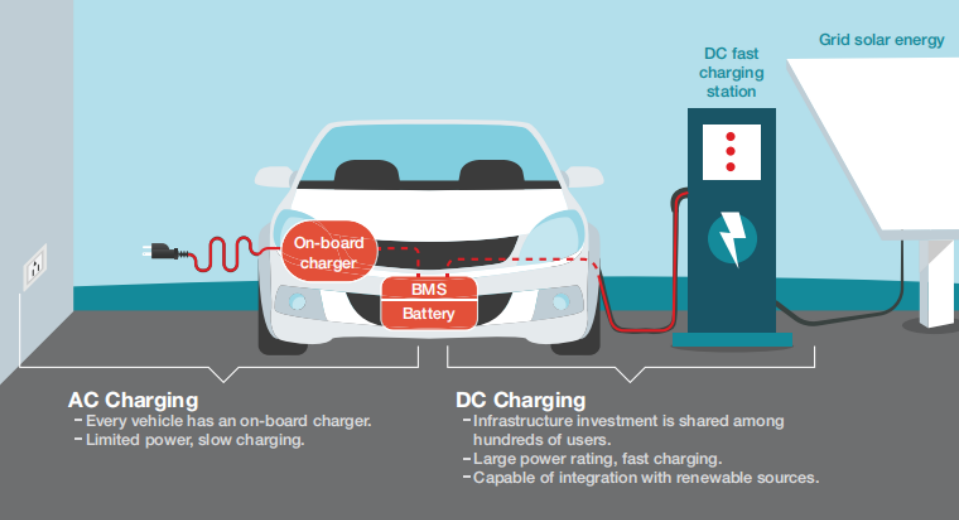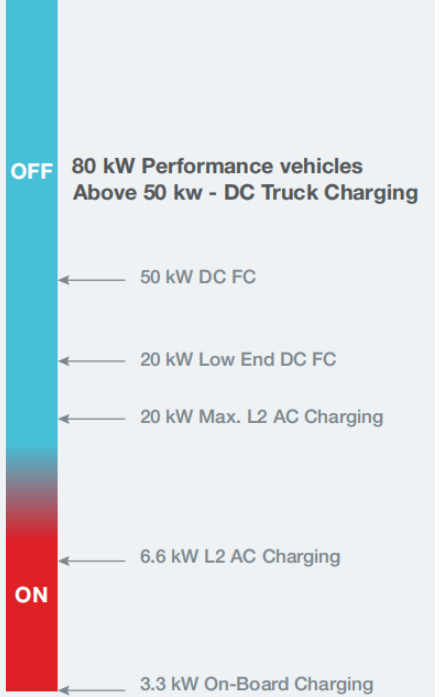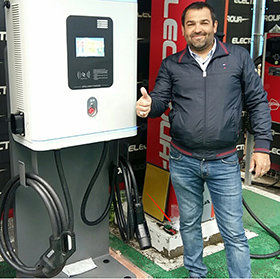Currently, there are three main charging methods for electric vehicles: off-board charger, which is installed outside the body of an electric vehicle and converts AC power to DC power; on-board charger, which is fixedly installed on an electric vehicle and converts AC power to DC power; and AC charging spot, which is a special power supply device that uses conduction to provide AC power to an electric vehicle with an on-board charging device.

As shown in the figure, the advantage of AC charging spot is that it saves the cost of charging post and is more flexible and convenient, but the charging power is low, and it increases the weight and design complexity of the body. DC charging, on the other hand, can output a higher power current, resulting in super fast charging.
AC charging piles or on-board chargers are generally 3.5KW, 7KW , 15KW power charging, while DC charging supports 20kW, with general specifications of 30KW, 60KW, 80KW, 120KW, 150KW, 180KW, etc.
The on-board 3.3 kW charger can charge a depleted 16 kWh battery pack in a PHEV to 95% in approximately 4 hours at 240 V power.

For AC charging stations, the Society of Automotive Engineers (SAE) has established standards, which are
Level 1 EVSE (typically residential chargers) use a household 120 VAC / 230 VAC power supply that can provide current in the range of 12 A to 16 A and can charge a 24 kWH battery in 12 to 17 hours.
Level 2 EVSE (typically used in commercial locations such as malls, offices, etc.) uses a multi-phase 240 VAC power supply to power more powerful vehicle chargers with currents between 15 A and 80 A and charges a 24 kWH battery in approximately eight hours.
Level 3 DC Charging Post: This type of charging station uses an external charger to supply up to 400 A of high-voltage (300 V-750 V) DC power directly to the vehicle battery.
Level 3 DC charging posts do not require on-board charge control because they are DC powered and have a higher output current power, with a typical 24 kWH battery taking less than 30 minutes to charge.
As defined by the International Electrotechnical Commission (IEC) mode definitions (IEC 62196 standard), then there are four charging modes.
Mode 1 - Slow charging from a regular power outlet (single-phase or three-phase).
Mode 2 - slow charging from a regular power outlet, but equipped with EV-specific protection devices.
Mode 3 - Slow or fast charging from a specific EV multi-pin socket with control and protection (according to SAE J1772 and IEC 62196 standards).
Mode 4 - Fast charging using special charger technology such as Charge de Move (CHAdeMO).
In addition, four plug types are available.
Type 1 - SAE J1772-2009 automotive plug specification for single-phase vehicle couplers.
Type 2 - Single-phase and three-phase vehicle couplers with VDE-AR-E 2623-2-2 plug specification.
Type 3 - Single-phase and three-phase vehicle couplers with safety shutters, a proposal of the EV Plug Alliance.
Type 4 - Fast charging couplers for special systems (e.g. CHAdeMO).
Safety codes and standards
Both on-board and off-board chargers need to comply with various codes set by regional governments and utility commissions, depending on where they are deployed. In general, these are the key safety and operational requirements that are mandated, specifically.
Electromagnetic compatibility (EMC) emission and immunity (US: FCC Part 15 Class A; European Union (EU) European Standards (EN): EN 55011, EN 55022 and IEC 61000-4).
Efficiency (96% and above).
Harmonic current total harmonic distortion (iTHD) <7% (in accordance with Institute of Electrical and Electronics Engineers [IEEE] 519 requirements).
Enclosure protection (e.g. IP54).
Connector type (CHAdeMO, Combined Charging System (CCS) 1 (SAE J1772 combined), CCS2 (IEC 61851-23), GB/T standard, etc.
Safety compliance (in the U.S. including: Underwriters Laboratories (UL) 2202, UL 2231-1 and UL 2231-2. in Europe: IEC 62196, IEC 61851, ConformitéEuropéene (CE)).

-- Marcus Groll,A Charging Station Owner in UKRAINE
Start your EV charging station businesses with Grasen. For a no-obligation quote, hit the button below, fill in your details, and we’ll get back to you.
